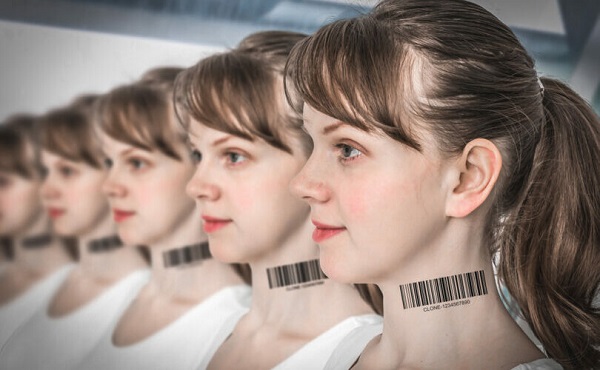Opinion
Some scientists advocate creating human bodies for ‘spare parts.’

From LifeSiteNews
The Stanford researchers admit that some people may find these ideas about clones repugnant but justify them on the basis of research already in progress.
In the 2005 sci-fi thriller The Island, Scarlett Johansson and Ewan McGregor discover that they are clones, created as an “insurance policy” for wealthy people who might need them for “spare parts.” Now, scientists at Stanford are proposing that we make this dystopian fiction a reality. On March 25, 2025, Carsten T. Charlesworth, Henry T. Greely, and Hiromitsu Nakauchi wrote in MIT Technology Review:
Recent advances in biotechnology now provide a pathway to producing living human bodies without the neural components that allow us to think, be aware, or feel pain. Many will find this possibility disturbing, but if researchers and policymakers can find a way to pull these technologies together, we may one day be able to create “spare” bodies, both human and nonhuman.
These researchers say that “human biological materials are an essential commodity in medicine, and persistent shortages of these materials create a major bottleneck to progress.” Using techniques reminiscent of Aldous Huxley’s Brave New World (in which fetuses destined for menial tasks are selectively poisoned to diminish their intelligence), they propose using human stem cells and artificial wombs to create human clones which they call “bodyoids.” The article describes it this way:
Such technologies, together with established genetic techniques to inhibit brain development, make it possible to envision the creation of “bodyoids”—a potentially unlimited source of human bodies, developed entirely outside of a human body from stem cells, that lack sentience or the ability to feel pain.
The researchers say that these neurologically impaired human clones could provide an almost unlimited source of organs, tissues, and cells for use in transplantation. They admit that some people may find these ideas repugnant but justify them on the basis of research already in progress. They correctly point out that we are already using neurologically injured people as research test subjects.
“Brain dead” people who are biologically alive but who have been declared legally dead are currently being used as test hosts for the implantation of genetically modified pig livers and kidneys. These brain-injured people who are being used as xenograft hosts are certainly alive (since they are stable enough to be used as test subjects for implanted animal organs) until they are killed at the end of the experiment for further anatomical and microscopic analysis. The Stanford scientists use this ethically problematic practice to justify creating human clones for research: “In all these cases, nothing was, legally, a living human being at the time it was used for research. Human bodyoids would also fall into that category.”
The scientists admit that human cloning raises ethical problems, saying that the use of bodyoids “might diminish the human status of real people who lack consciousness or sentience.” But the article is clearly written in the spirit of the ends justifying the means. In their call for action, the authors conclude, “Caution is warranted, but so is bold vision; the opportunity is too important to ignore.”
On the contrary, the value of every human being is what is too important to ignore. We value and protect every person because they are made in the image of God, regardless of the way they were brought into the world. Using unconscious people as research subjects is wrong, both in the case of brain-injured people declared “legally dead” (under the logical fallacy of brain death), and also with this new proposal for bioengineering human clones. Salve Regina University philosopher Dr. Peter J. Colosi explains it this way:
You, as the person who you are, exist even when you are not conscious, and this means that other human beings who are not conscious could also do that. In the branch of philosophy that I am calling Christian personalism, there have been many convincing arguments developed to show the reasonableness of the presence of a person in all classes of nonconscious or minimally conscious living human beings.
Also, it is wrong to create people with the sole purpose of using them to fulfill our own desires. Dr. Colosi makes this clear:
Furthermore, the creation of human beings with the deliberate intent to destroy some of them for the sake of others…is a clear example of what Pope Francis has referred to as “The Throw Away Culture”: The throwaway culture says, “I use you as much as I need you. When I am not interested in you anymore, or you are in my way, I throw you out.” It is especially the weakest who are treated this way — unborn children, the elderly, the needy, and the disadvantaged.”
Creating people to be used as commodities for “spare parts” is unconscionable. Do we really want to be spending our taxpayer dollars this way? Yet Stanford Medicine’s Center for Clinical and Translational Research and Education just received a $70 million NIH grant. The purpose of this grant is to “accelerate the translation of newly discovered biomedical treatments into interventions that improve patient care and population health.”
READ: The case of Zack Dunlap shows the incoherence of ‘brain death’
Rather than accelerating, we need to stop, expose, and defund these morally abhorrent attempts to purposely bioengineer neurologically impaired human clones as a source of “spare parts.” A pro-life ethic protects all human life from experimentation and abuse.
Heidi Klessig MD is a retired anesthesiologist and pain management specialist who writes and speaks on the ethics of organ harvesting and transplantation. She is the author of The Brain Death Fallacy, and her work may be found at respectforhumanlife.com.
Daily Caller
AI Needs Natural Gas To Survive


From the Daily Caller News Foundation
By David Blackmon
As recent studies project a big rise in power generation demand from the big datacenters that are proliferating around the United States, the big question continues to focus in on what forms of generation will rise to meet the new demand. Most datacenters have plans to initially interconnect into local power grids, but the sheer magnitude of their energy needs threatens to outstrip the ability of grid managers to expand supply fast enough.
This hunger for more affordable, 24/7 baseload capacity is leading to a variety of proposed solutions, including President Donald Trump’s new executive orders focused on reviving the nation’s coal industry, scheduled to be signed Tuesday afternoon. But efforts to restart the permitting of new coal-fired power plants in the US will require additional policy changes, efforts which will take time and could ultimately fail. In the meantime, datacenter developers find themselves having to delay construction and completion dates until firm power supply can be secured.
Datacenters specific to AI technology require ever-increasing power loads. For instance, a single AI query can consume nearly ten times the power of a traditional internet search, and projections suggest that U.S. data center electricity consumption could double or even triple by 2030, rising from about 4-5% of total U.S. electricity today to as much as 9-12%. Globally, data centers could see usage climb from around 536 terawatt-hours (TWh) in 2025 to over 1,000 TWh by 2030. In January, a report from the American Security Project estimated that datacenters could consume about 12% of all U.S. power supply.
Obviously, the situation calls for innovative solutions. A pair of big players in the natural gas industry, Liberty Energy and Range Resources, announced on April 8 plans to diversify into the power generation business with the development of a major new natural gas power plant to be located in the Pittsburgh area. Partnering with Imperial Land Corporation (ILC), Liberty and Range will locate the major power generation plant in the Fort Cherry Development District, a Class A industrial park being developed by ILC.
“The strategic collaboration between Liberty, ILC, and Range will focus on a dedicated power generation facility tailored to meet the energy demands of data centers, industrial facilities, and other high-energy-use businesses in Pennsylvania,” the companies said in a joint release.
Plans for this new natural gas power project follows closely on the heels of the March 22 announcement for plans to transform the largest coal-fired power plant in Pennsylvania, the Homer City generating station, into a new gas-fired facility. The planned revitalized plant would house 7 natural gas turbines with a combined capacity of 4.5 GW, enough power 3 million homes.
Both the Homer City station and the Fort Cherry plant will use gas produced out of the Appalachia region’s massive Marcellus Shale formation, the most prolific gas basin in North America. But plans like these by gas companies to invest in their own products for power needs aren’t isolated to Pennsylvania.
In late January, big Permian Basin oil and gas producer Diamondback Energy told investors that it is seeking equity partners to develop a major gas-fired plan on its own acreage in the region. The facility would primarily supply electricity to data centers, which are expected to proliferate in Texas due to the AI boom, while also providing power for Diamondback’s own field operations. This dual-purpose approach could lower the company’s power costs and create a new revenue stream by selling excess electricity.
Prospects for expansion of gas generation in the U.S. received a big boost in January when GE Vernova announced plans for a $600 million expansion of its manufacturing capacity for gas turbines and other products in the U.S. GE Vernova is the main supplier of turbines for U.S. power generation needs. The company plans to build 37 gas power turbines in 2025, with a potential increase to over 70 by 2027, to meet rising energy demands.
The bottom line on these and other recent events is this: Natural gas is quickly becoming the power generation fuel of choice to feed the needs of the expanding datacenter industry through 2035, and potentially beyond. Given that reality, the smart thing to do for these and other companies in the natural gas business is to put down big bets on themselves.
David Blackmon is an energy writer and consultant based in Texas. He spent 40 years in the oil and gas business, where he specialized in public policy and communications.
2025 Federal Election
‘Sadistic’ Canadian murderer claiming to be woman denied transfer to female prison

From LifeSiteNews
The logical decision to house the male murderer with men flies in the face of the Liberal Party’s official stance, which is to incarcerate prisoners according to their ‘self-identified’ gender.
A Canadian man who butchered his family and now claims to be a woman will not be allowed to transfer to a female prison.
On April 8, Correctional Services Canada (CSC) announced that Mohamad Al Ballouz, who brutally murdered his wife and two children, will be sent to a men’s prison, despite claiming to be a woman, according to CTV News.
“When there are overriding health and safety concerns, the request is denied and alternatives are put in place to meet the offender’s gender‑related needs at the institution where they are incarcerated,” the CSC statement reads.
Following an assessment of Al Ballouz request, CSC confirmed that he “will be incarcerated in a men’s institution.”
On December 16, Al Ballouz, a 38-year-old from Quebec, was found guilty second-degree murder of his wife Synthia Bussières, first-degree murder of five-year-old Eliam and two-year-old Zac, and one count of attempted arson.
Crown prosecutor Éric Nadeau revealed that the murder took place in September 2022 when Al Ballouz slaughtered his family at their Brossard apartment. He stabbed his wife 23 times before suffocated his children and trying to set the apartment on fire. He then ingested windshield washer fluid, which is believed to have been a suicide attempt.
During the trial, Quebec Superior Justice Eric Downs described Al Ballouz, as having a “sadistic character” and being “deeply narcissistic.” He was sentenced to life imprisonment with no chance of parole for 25 years.
Throughout the trial, Al Ballouz, a biological male, claimed to be a woman and demanded that he be referred to as “Levana,” a change which was made after he was charged for his crimes. Notably, the Canadian Broadcasting Report’s (CBC’s) report of the case refers to the convicted murder as “she” and uses his fake name.
Following his sentencing, the murderer requested to be sent to the Joliette Institution for Women; however, Downs responded that is a decision for Correctional Service Canada.
Currently under the Liberal Party, the policy is to place prisoners according to their “self-identified” gender, not according to biology. As a result, male rapists and murderers can be sent to prison with females.
However, Al Ballouz’s case caused an uproar on social media as many pointed out that putting the murderer in a women’s prison would pose a danger to female inmates.
Conservative Party leader Pierre Poilievre has condemned the Liberal policy and promised that he would end this practice if elected.
“Surreal: A man who killed his wife and two kids now claims he is a woman to go to a female prison,” he wrote in a December 22 post on X.
“I can’t believe I have to say this: but when I’m PM, there will be no male prisoners in female jails,” Poilievre continued. “Period.”
-

 Also Interesting2 days ago
Also Interesting2 days agoMortgage Mayhem: How Rising Interest Rates Are Squeezing Alberta Homeowners
-

 Justice2 days ago
Justice2 days agoCanadian government sued for forcing women to share spaces with ‘transgender’ male prisoners
-

 Alberta2 days ago
Alberta2 days agoAlberta takes big step towards shorter wait times and higher quality health care
-

 Business1 day ago
Business1 day agoStocks soar after Trump suspends tariffs
-

 COVID-191 day ago
COVID-191 day agoBiden Admin concealed report on earliest COVID cases from 2019
-

 MAiD2 days ago
MAiD2 days agoDisability rights panel calls out Canada, US states pushing euthanasia on sick patients
-

 COVID-192 days ago
COVID-192 days agoRandy Hillier wins appeal in Charter challenge to Covid lockdowns
-

 Business2 days ago
Business2 days agoTrump raises China tariffs to 125%, announces 90-day pause for countries who’ve reached out to negotiate




